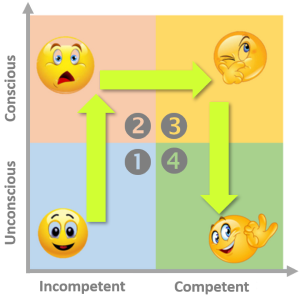We’ve all had that repeated feeling – tumbling-down a rabbit hole of complexity only to conclude that the GPS signal is lost.

We’re like Alice in Wonderland in the search of where to go. Alice encountered the Cheshire Cat, hoping that it could coach her in the process of deciding where to go.
“That depends a good deal on where you want to get to,” said the Cat.
“I don’t much care where—” said Alice.
“Then it doesn’t matter which way you go,” said the Cat.
“—so long as I get somewhere,” Alice added as an explanation.
“Oh, you’re sure to do that,” said the Cat, “if you only walk long enough.” —
Alice in Wonderland: Dialogue between Alice and the Cheshire Cat

The ambition with this post is to discuss strategies for coaching people maneuvering a landscape filled with deep rabbit holes – and hopefully be of more help than the Cheshire Cat.
Coaching
The importance of coaching is not new, but might have been underestimated. If you haven’t already done it, read Marty Cagan‘s important book EMPOWERED focusing a lot on exactly that – coaching (the whole Part II is reserved for this single topic).
Marty Cagan is clearly a big fan of Bill Campbell (coach to Steve Jobs and other Silicon Valley leaders), quoting him in the book:
Bill Campbell

In essence coaching is about helping people grow competences in a given field – personal or professional.
There is unfortunately no shortcut escaping the hard work and pain growing competences – just like the kid learning to ride a bike … but coaching can help accelerate the process:
- The young kid is blissfully unaware of the hard fact: it cannot ride a bike.
- First time on the bike resulting in bruised knees: now the kid is painfully and consciously aware of not being able to ride a bike.
- Luckily the kid has a coach – dad – helping to gain balance. Now the kid just barely is able to ride the bide without falling-over: very conscious about the newly gained competence.
- As time goes the kid effortlessly rides the bike: it has become unconscious about the bike-riding competence.

Coaching people in a complex and fast-changing environment
Yes – I know – the field of coaching is a deep rabbit-hole in its own right. This post will not
- attempt to survey the huge amount of general coaching literature
- focus on specific frameworks – read e.g., Coaching Agile Teams
Based on my own experience, I’ll here share the essence of what I’ve learned has worked in a fast-moving and complex environment with highly educated and bright people.
Let's set the scene
The individuals being coached here are specialized in their field being Product Management, Project Management, Product Designer, Software Specialist etc. For the coach to be effective, he/she needs to have been there and done that.
You do not want to be (professionally) coached by a person having taking all the right coaching educations and having read all the right coaching literature, but not having a deep understanding of and experience in the subject.
Being a manager you’ll easily yourself get caught in rabbit holes, making it important remind yourself what your priorities are.
Marty Cagan, EMPOWERED page 34
As outlined earlier, coaching is an integral part of the larger discipline being Servant Leadership.
Strategies
First I’ll share some general recommendations and tools. Secondly, to be specific, I’ll provide an example scenario.
General recommendations and tools
In lack of a better word for the person being coached, I’ll use the term “coachee”.
Recommendation #1
If you’re like me, talking (too) much, it is imperative to remind yourself of the fact: you have two ears and one mouth meaning you should listen more than talking.
Recommendation #2
Remind yourself of Steve Job’s wise words:
Steve Jobs
Being highly knowledgeable and experienced in the subject, it is very tempting to serve the solution. Don’t – you’ll deprive the coachee from an important learning process.
Recommendation #3
Do not make coaching something academic a using a smart coaching terminology (it is ok and beneficial to read the endless list of coaching literature, but keep the smart models and terms where they belong – in the books).
Recommendation #4
Do not get caught by the “Agile Coach” / “Scrum Master syndrome” celebrating that you now have 287 variations of how to facilitate a sprint retrospective (of course using your own nice hand-drawings – oh no, never use Power Point.. ). NB This type of Scrum Master has too much free time – let him do some coding instead!
Keep it Simple, Sweet and to the Point. Do not distract the coaching process with “smart” facilitation.
Feel free to survey the endless list of coaching tools and methods. Professional coaching is not rocket science. It only takes a few – but important – elements
- Be authentic and have an honest intention to help the person / team to grow
- You need to have been there and done that yourself (e.g., how can you coach a Project Manager, if you’ve not acted as one yourself?)
- Have a toolbox with a few but strong tools – do not go crazy with exotic techniques – see Recommendation #4
Tool #1
Five key questions
You need to uncover what is at stake – what is the point to address. Five questions help you uncover that:
- WHO?
- WHAT?
- WHERE?
- WHEN?
- HOW?
You job as a coach is now to help your coachee identify, what is at stake.
Tool #2
Visualization
The closest thing we come to time-travel, is our cognitive capacity enabling us to visualize a future state in time. This is a very strong tool used in e.g., elite sports and project management (as outlined here).
You as a coach can help the coachee to see the big picture and to spark creativity on how to approach a challenging situation.
One specific approach is the written narrative.
Example scenario
You’ve hired a young and fairly unexperienced Project Manager (now called your coachee). She does have a lot of education and theoretical insight, but lacks practical experience.
Your organization has been through a process, aiming for a Minimum Viable Process Prescription combined with a highly versatile Pick & Use Toolbox.
Your coachee has come to you feeling stuck, not knowing how to get her primary stakeholders on the same page. “What they ask of me points in all directions” she says and brings attention to the Project Process Model – “I’ve searched through the processes, templates and checklists without any luck – I’m stuck, and I’m honestly a bit intimidated by these senior stakeholders“.
This is a classic example of an unexperienced Project Manager being too dependent on process prescriptions telling her what to do. She has jumped into a rabbit hole only to loose a sense of direction. Your job as a coach is to help her regain signal on her GPS.
Using Tool #1 you help her become specific and concrete on the issue blocking her. That process alone is very helpful for her – just explaining the problem triggers her to think in terms of solutions.
Now having uncovered the core problem and having considered solution alternatives, you facilitate a visualization process using Tool #2. “Let’s imagine that you’ve called the stakeholders to an alignment meeting and apply the solution approach we just talked about, what will happen?“, you ask – “how can you come prepared to the meeting without feeling intimidated?“
You’ve got the point by now. Layer by layer you peel the onion until your coachee has gained confidence what to do – she has a strong signal on the GPS again!
Wrap-up
You as a leader / manager have an important responsibility, coaching your employees / teams. The trick is to keep it simple, sweet and to the point.

